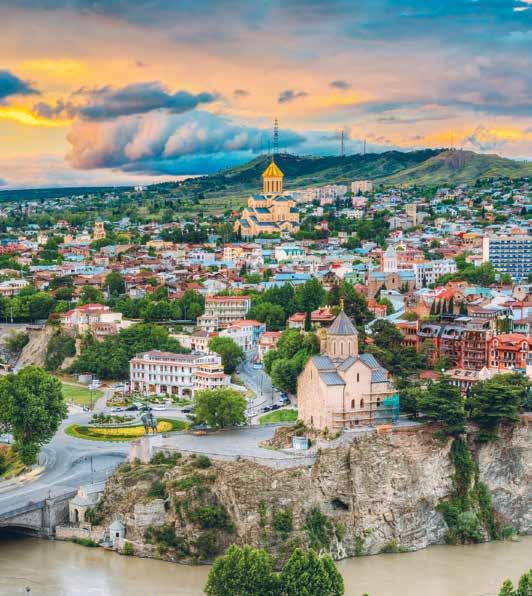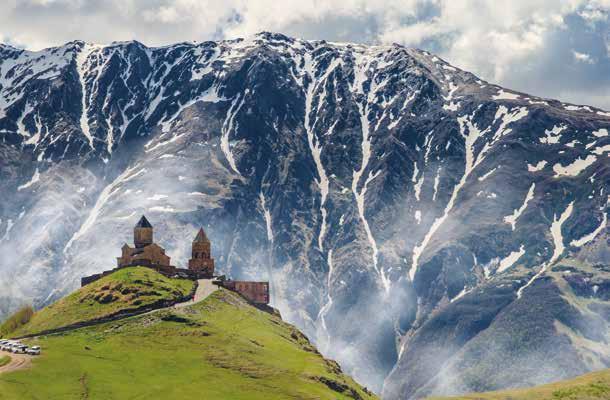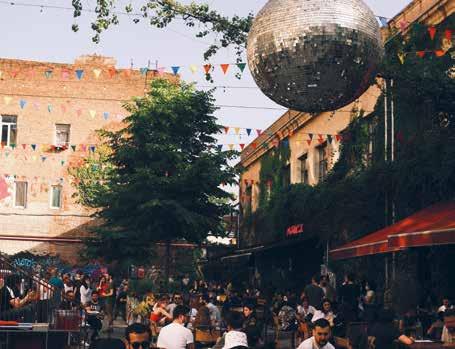
5 minute read
SPOTLIGHT ON GEORGIA
The best-kept secret, where Eastern Europe meets Western Asia.
What do you know about Georgia? No, not the 4th state of the United States Georgia – the other one! The one that is staggeringly diverse. A mix of mountains, monasteries, and museums; of warmth, wine, and welcoming people. Here’s all you need to know in a nutshell.
The small mountainous country of Georgia is uniquely situated where Europe meets Asia. Although geographically classed as Asia, historically, socially, and culturally Georgia has much closer ties with Europe. In under a decade, the country has gone from being almost totally off the tourist radar to the most visited country in the South Caucasus. And it’s not hard to see why. Whether you’re looking to hike through stunning mountain scenery, visit historic cave towns and monasteries, or explore cosmopolitan cities, Georgia has it all.
5 must-see Georgian highlights:
1
Tbilisi
A fantastic starting point for any trip to Georgia, Tbilisi is Georgia’s capital city, and a real melting pot of old and new. Discover ornate synagogues, 18th-century mosques, Georgia’s oldest basilica, medieval Armenian churches and a Zoroastrian Fire-Worshipper’s temple. For something more contemporary, head to the waveshaped Peace Bridge that stretches across the Kura River, connecting Old Tbilisi with the city’s more modern districts. After a busy day of sightseeing, wander through quaint narrow streets and faded 19th-century wooden buildings, and kick back in a quirky street-side cafe while observing the bustle of local life. For a glimpse into modern Georgian life, visit the Marjanishvili district in Tbilisi with plentiful wine bars, restaurants and colourful street art.
2 3
Kazbegi

You’ll find emerald-green alpine meadows and towering snow-capped mountains in the Kazbegi region of Georgia. Spanning over 8,700 hectares on the northern slopes of the Caucasus ranges, Kazbegi National Park is home to a variety of flora and fauna. You may also spot a pack of roaming wolves or a solitary bear foraging for food amongst the jagged peaks. Don your walking boots and trek along the dusty mountain paths to the dizzy heights of Gergeti village and make a pilgrimage to the Church of the Holy Trinity set upon a blanket of green in a natural amphitheatre of craggy mountains. Cloaked in mythology and religious tradition, Mount Kazbegi is the place where the Greek Titan Prometheus was chained for all eternity, and ancient Abrahamic relics are said to have been discovered here.
Uplistsikhe Cave Town
Step back in time and head to the Silk Road cave town of Uplistsikhe on the banks of the Mtkvari River to uncover an entire town of streets, churches, palaces and homes carved into the mountainside. Dating back to the first millennium BC, the town became a prominent city on the trade route of Byzantium with India and China and age-old relics from the Bronze and Middle Ages have been discovered here. Walk through vaulted chambers chiselled into the ivory-coloured rock, peer into hollow caverns that once housed the sacred shrines of religious ceremonies and sit on the cascading tiers of a timeworn amphitheatre.
4 5
Sighnaghi
Set upon a verdant hilltop in the Kakheti region, the pretty town of Sighnaghi, also known as the ‘Paris of Georgia’, boasts far-reaching views of the Khaketi Winelands against a dramatic backdrop of the towering Greater Caucasus mountain ranges. Stroll along the cobbled streets lined with 18thcentury dwellings, overhanging wooden balconies and terracotta tiled roofs, and visit a 16th-century wine cellar to sample some of the region’s delicious red and white wines that have been produced here for over 300 years.

Svaneti

Get off the beaten track with a trek into Georgia’s Svaneti region. Set amongst the snow-capped peaks and deep gorges of the Greater Caucasus Mountains, indigenous communities reside in its remote villages. Medieval stone towers known as koshki are dotted within the verdant landscape, and mighty glaciers slide down the valleys toward the inky-blue lakes and rivers. Stay in the village of Becho in the dominating shadow of Mount Ushba known as the ‘Matterhorn of the Caucasus,’ and meet the local Svan people to learn about their unique culture and age-old traditions.
Top tip from Vale Chironna, Explore’s Product Manager for Georgia...
Travel
Culinary Georgia
If, like us, you love to find out all you can about a destination before you go, here’s our recommendations to get in the Georgian spirit…

The book to read: Ali & Nino by Kurban Said Georgia’s version of Romeo and Juliet and very much a celebrated classic.
The film to watch: Chemi Bednieri Ojakhi (My Happy Family) Hop on Netflix and watch this enthralling movie showcasing parts of Georgian society.
The music to try: Mgzavrebi
A Georgian folk/rock band made up of 7 musicians, Mgzavrebi’s songs will take you on a musical journey.
In Georgia, guests are believed to be a ‘gift from God’. When attending a supra (a traditional Georgian feast) you’ll be welcomed joyously and a tamade (a toastmaster) will look after you and make sure you are always entertained and provided with food and drink. Want to join in? Raise a glass and say “Gaumarjos!” (cheers).
Georgia is fast becoming a foodie destination, with a focus on locally produced ingredients, hearty dishes and cheese (lots of it!). The so-called ‘national dish’ of Georgia, khachapuri is the perfect winter warmer. This traditional leavened bread is canoe-like in shape, with gooey melted sulgani cheese baked into the middle, then topped with chunks of butter and an egg cracked onto the top. It’s ubiquitous across Georgia and can be found at most hole-in-the-wall bakeries and restaurants. Each region has its own twist with vegetables or different meats, so you’ll just have to try them all!
Making the Georgian soup dumpling khinkali is an art form – experienced cooks will tell you that any fewer than 20 folds is the work of an amateur – but when faced with a plate piled with these slippery, meat-broth-filled parcels you’ll find yourself too distracted by the delicious aromas to count them. Eating khinkali has a specific set of rules too: they’re finger foods, with the little knot at the top used for lifting them. You then bite a hole in the side to slurp out the soup before eating the rest of the dumpling, discarding the knot.
Churchkhela look like sausages but are in fact colourful sweets made from walnuts with concentrated grape juice left over from the annual wine harvest. Each layer is left to dry until the whole strand is enveloped in a dry, waxy crust – tastier than it sounds. You’ll see churchkhela for sale everywhere on the side of the road and they’re considered a staple of Georgian cuisine, even being taken to war by Georgian soldiers as a boost of protein (and sugar).
Georgia is considered the birthplace of wine. Kakheti is Georgia’s most well-regarded wine region and one of the oldest in the world. With many natural springs and mineral-rich water from the Caucasian Mountains, as well as warm summers and mild winters, Georgia’s climate is ideal for wine production. Head to Kondoli to learn about the organic farming methods used to harvest special bio wines. Georgia also has a unique wine-making process that involves storing pressed grape juice underground in large qvevris pots (egg-shaped clay caskets) while it ferments. The story goes that 8,000 years ago some lucky soul poured grape juice in an earthenware jar and buried it in a pit which resulted in Georgia’s first glass of red.
You’ll find all our tours to Georgia at exploreworldwide.ca/Georgia
Above The national dish khachapuri Left Square life in Georgia Destination Guide 35 exploreworldwide.ca











